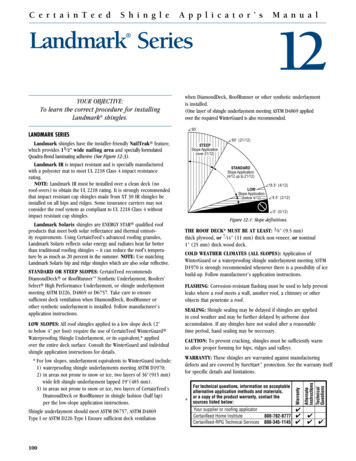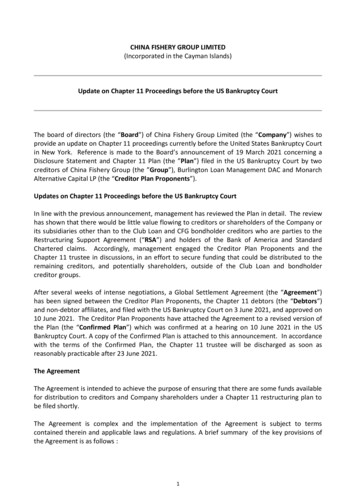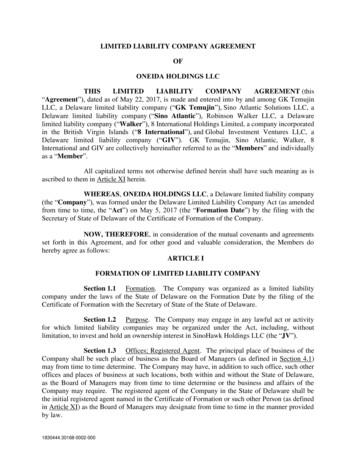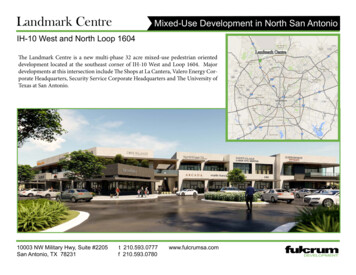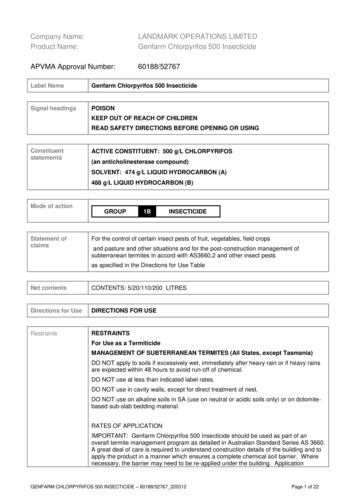
Transcription
Company Name:Product Name:LANDMARK OPERATIONS LIMITEDGenfarm Chlorpyrifos 500 InsecticideAPVMA Approval Number:60188/52767Label NameGenfarm Chlorpyrifos 500 InsecticideSignal headingsPOISONKEEP OUT OF REACH OF CHILDRENREAD SAFETY DIRECTIONS BEFORE OPENING OR USINGConstituentstatementsACTIVE CONSTITUENT: 500 g/L CHLORPYRIFOS(an anticholinesterase compound)SOLVENT: 474 g/L LIQUID HYDROCARBON (A)488 g/L LIQUID HYDROCARBON (B)Mode of actionStatement ofclaimsGROUP1BINSECTICIDEFor the control of certain insect pests of fruit, vegetables, field cropsand pasture and other situations and for the post-construction management ofsubterranean termites in accord with AS3660.2 and other insect pestsas specified in the Directions for Use TableNet contentsCONTENTS: 5/20/110/200 LITRESDirections for UseDIRECTIONS FOR USERestraintsRESTRAINTSFor Use as a TermiticideMANAGEMENT OF SUBTERRANEAN TERMITES (All States, except Tasmania)DO NOT apply to soils if excessively wet, immediately after heavy rain or if heavy rainsare expected within 48 hours to avoid run-off of chemical.DO NOT use at less than indicated label rates.DO NOT use in cavity walls, except for direct treatment of nest.DO NOT use on alkaline soils in SA (use on neutral or acidic soils only) or on dolomitebased sub-slab bedding material.RATES OF APPLICATIONIMPORTANT: Genfarm Chlorpyrifos 500 Insecticide should be used as part of anoverall termite management program as detailed in Australian Standard Series AS 3660.A great deal of care is required to understand construction details of the building and toapply the product in a manner which ensures a complete chemical soil barrier. Wherenecessary, the barrier may need to be re-applied under the building. ApplicationGENFARM CHLORPYRIFOS 500 INSECTICIDE – 60188/52767 220312Page 1 of 22
equipment must be fitted with a flow meter and pressure regulator on the applicationdevice. The purpose of a chemical soil barrier is to impede and discourage concealedtermite entry into a structure. Barriers may still be bridged by termites, but their entrycan then be more easily detected during routine inspections. If a barrier is not completeor breached, then concealed termite entry may occur. It is often not possible to form acomplete barrier around existing structures in which case other termite managementoptions and/or more frequent inspections will also need to be considered.GENERAL PEST CONTROLDO NOT spray polycarbonate surfaces/roof sheeting or aged vinyl wall cladding assolvent may cause ING PERIODSDO NOT GRAZE OR CUT CEREALS, PASTURES OR FORAGE CROPS FOR STOCKFOOD FOR 2 DAYS AFTER APPLICATION.TURF: DO NOT FEED TURF/LAWN CLIPPINGS FROM TREATED AREA TO POULTRY ORLIVESTOCK.COTTON: DO NOT HARVEST FOR 4 WEEKS AFTER APPLICATION. DO NOT GRAZEOR CUT FOR STOCK FOOD FOR 4 WEEKS AFTER APPLICATION.DO NOT HARVEST THE FOLLOWING CROPS UNTIL THE NUMBER OF DAYS STATEDBELOW HAS ELAPSED, AFTER SPRAYING:MangoAsparagus, Bananas, Citrus, Grapevines, Kiwifruit, Pome Fruit,Stone Fruit, CeleryCereal Grain CropsAvocado, Sugar CaneCole Crops, CucurbitsTomatoesSorghum Grain Crops21 days14 days10 days7 days5 days3 days2 daysTradeadviceGeneralinstructionsGENERAL INSTRUCTIONS(For Use as a Termiticide)APPLICATION INSTRUCTIONSAPPLICATION EQUIPMENTHand SprayingFor hand spraying use a rose head shrouded nozzle, operating at 170 kPa, with a flow meterand pressure regulator fitted to the hand-piece.Treatment Beneath Concrete Slabs or Sealed AreasWhere it is not possible or practical to remove the slab to allow direct application to the soil, usea sub-slab injector fitted with multi-directional tip (eg. a B&G or similar system) with a 5 degreeupward angle (eg. 3 way or 4 way) operated at 170 kPa. Ensure a strong seal with the top ofGENFARM CHLORPYRIFOS 500 INSECTICIDE – 60188/52767 220312Page 2 of 22
the drill hole to avoid leakage. For the best distribution, the injector needs to be held vertically,at right angles to the slab, and rotated during the application through 90 degrees (if using a 4way dispersion tip), or through 120 degrees (for a 3 way dispersion tip).Injection into SoilWhere it is not possible or practicable to trench the soil; use a soil rod with a 3 or 4 way multidirectional tip (B&G, or similar) operated at 170 kPa. The 4 way tip needs to be rotated duringthe application through 90 degrees and the 3 way tip through 120 degrees.APPLICATION VOLUME2To compensate for impervious soils such as heavy clay where application of 5L/m would cause2run-off, it may be necessary to apply a volume of emulsion less than 5L/m . When reducing thetotal volume of emulsion used, increase the concentration accordingly to match the label rate by2mixing the required amount of Genfarm Chlorpyrifos 500 Insecticide per m in a lesser volumeof water. DO NOT use emulsion volumes less than 2L for every square metre to be treated.2Note: Use of emulsion volumes other than the recommended 5L/m is only permitted wheninstalling barriers in exposed soil. It is not permitted when injecting through the slab or intosealed areas.Existing Structuresa) Strategic Drilling Through Slab or Sealed AreasFor treatment of slabs when termites are entering the building through the slab, wherereticulation systems do not exist, slab drilling and injection will be required. In mostcases, unless there is a known severe termite hazard, grid drilling of the slab is notrequired. Any such need is to be determined by a licensed Pest Manager.Treatment needs to be made around the inside of all exterior walls to complete a termitebarrier, along both sides of interior wall partitions, around plumbing/electrical or pipingentry points and along major cracks or expansion joints. When treating along majorcracks or expansion joints it is recommended that holes are drilled alternately on eitherside of the crack at the recommended drill hole spacings.For a sand base or sandy soil, apply through a row of holes drilled no more than 300mmapart and 100-200mm out from the wall, crack or pipe. For a clay base, apply through arow of holes drilled 150mm apart and 100mm from the wall, crack or pipe. Apply 10L ofemulsion per linear metre and ensure the holes are securely plugged after treatment.b) External BarriersAn external barrier should be installed around the perimeter of the building and shouldcircumference all pipes and service facilities. External barriers should be created byusing either a vertical or horizontal barrier, as determined by the building constructiontype and adjoining ground level. An external barrier is an essential part of thetreatment when relying on a chemical soil barrier to provide the full termitemanagement system as per AS 3660.An external horizontal barrier is only required when prevention of concealed verticalaccess by termites is necessary at the perimeter. (eg. when ground level is equal to thetop of a slab, where the slab is also a barrier to concealed termite movement into thebuilding). A vertical barrier is required when prevention of concealed horizontal accessis necessary (eg. where ground level is higher than building material vulnerable toconcealed horizontal entry by termites).i)ii)Horizontal Barrier: Use a rose head shower nozzle operated at 170 kPa toapply the required rate of 1.5L of the correctly diluted Genfarm Chlorpyrifos 500Insecticide per lineal metre (150mm wide) to soil loosened to a depth ofapproximately 80mm (see APPLICATION VOLUME Section).Vertical Barrier: The vertical barrier should be at least 150mm wide and shouldreach down to 50mm below the top of the footings. To achieve this, trench tothe top of the footings, and where this is not possible, a combination of trenching(preferably at least 300mm deep) and rodding into the base of the trench mayGENFARM CHLORPYRIFOS 500 INSECTICIDE – 60188/52767 220312Page 3 of 22
be necessary.Apply Genfarm Chlorpyrifos 500 Insecticide emulsion at 100L per cubic metre ofbackfill soil, this equates to 1.5L of emulsion/linear metre of a trench 150mm wideand 100mm deep. Where the required vertical barrier is deeper than 100mm,ensure the same rate of application for the extra volume of soil. Use a rose headshower nozzle operated at 170 kPa to flood the base of the open trench and alsoto treat the backfill soil as it is replaced into the trench to ensure even distribution.Where rodding is necessary, rod before the trench is treated using the spacingsin the following table.Rod SpacingsHeavy ClayClay LoamsSands150 mm200 mm300 mmInsert the rod to the foundation foot as close as possible to the house wallensuring the chemical is applied during insertion and withdrawal.(SeeAPPLICATION EQUIPMENT section, Injection into Soil).c) Suspended FloorsInstall horizontal and vertical barriers as specified in Australian Standard Series AS 3660 toadjoin all substructure walls, stumps, piers, pipes and wastes using the techniques describedfor external barriers around concrete slabs. (See Existing Structures Section.)GENERAL INSTRUCTIONS - Termite ManagementTermite ManagementTo minimise the risk of termite infestation, the subfloor area of buildings should be kept free ofstored or waste timber and all other building materials that attract termites. Appropriate actionshould also be taken to eliminate any undue dampness caused by leaking water or seweragepipes, or inadequate drainage. Subterranean termites need a constant source of moisture tosurvive. Provision of adequate ventilation in the subfloor area also helps to eliminate unduedampness. Pest managers using this product for termite management should advise the homeowner that disturbing the treated soil barrier with subsequent construction of additions oralterations, paths, steps, landscaping etc., may render the termite management system in placeineffective unless further management options are considered.Colonies not in contact with the groundOccasionally subterranean termites establish a colony in a building without having contact withthe soil because they have access to a continuous supply of moisture (eg. from a faultyplumbing fixture or leaking roof). Such colonies are not affected by chemical soil barriers andshould be treated as recommended for established colonies, as per Australian Standard SeriesAS 3660. Genfarm Chlorpyrifos 500 Insecticide may be applied directly to the termite colony insuch situations.Service RequirementRegular, competent inspections by a licensed Pest Manager are recommended as part of anoverall termite management program to determine the prevailing termite pressure andenvironmental conditions and consequent requirement for further termite management options.Inspections should be performed at least on an annual basis, but more frequent inspections arestrongly recommended.At the 1% application rate, Genfarm Chlorpyrifos 500 Insecticide can provide an effectivechemical soil barrier in subfloor regions for 4 years or more north of the Tropic of Capricorn,and 10 years or more south of the Tropic of Capricorn. At the 1% application rate, GenfarmChlorpyrifos 500 Insecticide can provide an effective chemical soil barrier in exposed situationsfor 2 years or more north of the Tropic of Capricorn, and up to 5 years or more south of theTropic of Capricorn.At the 2% application rate north of the Tropic of Capricorn, Genfarm Chlorpyrifos 500Insecticide can provide an effective chemical soil barrier in subfloor regions for 6 years or moreand in exposed situations for up to 3 years or more.GENFARM CHLORPYRIFOS 500 INSECTICIDE – 60188/52767 220312Page 4 of 22
The actual period of efficacy will depend on factors such as termite hazard, climatic conditions,soil types and soil disturbance and gardening/landscaping practices.GENERAL INSTRUCTIONS - For use as a TermiticideMIXINGHalf fill the spray tank with water (or creosote where applicable) and add the required amount ofGenfarm Chlorpyrifos 500 Insecticide, then add the remaining water (or creosote) with anagitator running. If using a knapsack sprayer gently shake before using. Only mix sufficientchemical for each specific application.CLEANING SPRAY EQUIPMENTAfter using Genfarm Chlorpyrifos 500 Insecticide, empty the spray equipment completely anddrain the whole system. Thoroughly wash inside the tank using a pressure hose, and drain. Towash the system, quarter fill the tank with clean water and circulate through the pump, lines,hoses and nozzles (for knapsack sprayers spray to waste through the nozzle). Drain andrepeat the washing procedure twice. Dispose of rinsate/rinse water in accordance with Storageand Disposal Instructions below.GENERAL INSTRUCTIONS: FOR USE AS AN INSECTICIDEThorough coverage is essential.For application by aircraft apply in 10-50 L of water/ha.MIXINGSlowly add the required amount of product to the water in the spray tank under agitation.Dilute Spraying Use a sprayer designed to apply high volumes of water up to the point of run-off andmatched to the crop being sprayed. Set up and operate the sprayer to achieve even coverage throughout the crop canopy.Apply sufficient water to cover the crop to the point of run-off. Avoid excessive run-off. The required water volume may be determined by applying different test volumes, usingdifferent settings on the sprayer, from industry guidelines or expert advise. Add the amount of product specified in the Directions for Use table for each 100L of water.Spray to the point of run-off. The required dilute spray volume will change and the sprayer set up and operation mayalso need to be changed, as the crop grows.Concentrate Spraying Use a sprayer designed and set up for concentrate spraying (that is a sprayer which applieswater volumes less than those required to reach the point of run-off) and matched to thecrop being sprayed. Set up and operate the sprayer to achieve even coverage throughout the crop canopy usingyour chosen water volume. Determine an appropriate dilute spray volume (see Dilute Spraying above) for the cropcanopy. This is needed to calculate the concentrate mixing rate. The mixing rate for concentrate spraying can then be calculated in the following way:EXAMPLE ONLY1. Dilute spray volume as determined above: For example 1500 L/ha2. Your chosen concentrate spray volume:GENFARM CHLORPYRIFOS 500 INSECTICIDE – 60188/52767 220312For example 500 L/haPage 5 of 22
3. The concentration factor in this example is: 3 X (i.e. 1500 L 500 L 3)4. If the dilute label rate is 10 mL/100L, then the concentrate rate becomes 3 x 10, that is 30mL/100L of concentrate spray.5. The chosen spray volume, amount of product per 100L of water, and the sprayer set up andoperation may need to be changed as the crop grows.For further information on concentrate spraying, users are advised to consult relevant industryguidelines, undertake appropriate competency training and follow industry Best Practices.SOIL APPLICATIONIn-Furrow: Apply as a band spray to the open furrow at planting. Spray the entire furrow tilthusing a nozzle located directly behind the seed tube. Ensure all spray is directed into thefurrow contacting bottom, sides and all soil drawn in to the furrow at closure. Use a minimum of20 L of water/ha. Use the higher rate under extreme population numbers.BAIT APPLICATIONBran bait:Mix 10 mL/kg of bran using sufficient water to give a moist crumb structure.Allow to stand for 2-3 hours before application. Gloves should be worn when preparing andapplying the bait.Cracked wheat or cracked sorghum bait:Mix the required volume of GenfarmChlorpyrifos 500 Insecticide and sunflower oil together. Then, add to the wheat or sorghum,mixing thoroughly. Gloves should be worn when preparing and applying the bait.COMPATIBILITYGenfarm Chlorpyrifos 500 Insecticide is compatible with the following:HerbicidesI1Atrazine, bromoxynil, chlorsulfuron, diclofop-methyl, diuron, flamprop-methyl,fluometuron, glyphosate, paraquat, paraquat diquat, pendimethalin,trifluralin.Insecticides and MiticidesAcephate, azinphos-methyl, carbaryl, cypermethrin, deltamethrin, demeton-Smethyl, diazinon, dichlorvos, dicofol, dimethoate, endosulfan, ethion,fenvalerate, maldison, methidathion, methomyl, monocrotophos, oils,oxythioquinox, parathion, phosalone, phosmet, tetradifon, trichlorfon.FungicidesChlorothalonil, thiram, triadimefon, zineb, ziram.FertilisersDiammonium phosphate, limestone, miloreanite, monoammonium sulphate,potash, sulphur coated urea, triple superphosphate, urea.INCOMPATIBILITYGenfarm Chlorpyrifos 500 Insecticide is NOT compatible with the following:Herbicides2,4-D, Dicamba, MCPA, Tordon* 75-D, Tordon*242.FungicidesFixed coppers, liquid and organic coppers, wettable sulphur.FertilisersIron sulphate, manganese sulphate, zinc oxysulphate.GENFARM CHLORPYRIFOS 500 INSECTICIDE – 60188/52767 220312Page 6 of 22
ResistancewarningINSECTICIDE RESISTANCE WARNINGGROUPIBINSECTICIDEFor insecticide resistance management Genfarm Chlorpyrifos 500 Insecticide is a Group 1Binsecticide. Some naturally occurring insect biotypes resistant to Genfarm Chlorpyrifos 500Insecticide and other Group 1B insecticides may exist through normal genetic variability in anyinsect population. The resistant individuals can eventually dominate the insect population ifGenfarm Chlorpyrifos 500 Insecticide or other Group 1B insecticides are used repeatedly. Theeffectiveness of Genfarm Chlorpyrifos 500 Insecticide on resistant individuals could besignificantly reduced. Since occurrence of resistant individuals is difficult to detect prior to use,Landmark Operations Limited accepts no liability for any losses that may result from the failureof Genfarm Chlorpyrifos 500 Insecticide to control resistant insects.Genfarm Chlorpyrifos 500 Insecticide may be subject to specific resistance managementstrategies. For further information contact your local supplier or Landmark Operations Limitedrepresentative.PrecautionsFor Use as a TermiticidePRECAUTIONSDO NOT apply inside buildings except as a crack and crevice treatment. DO NOT apply tosurface areas such as interior floors and walls.RE-ENTRY TO TREATED AREASDO NOT permit re-occupation of any premises until treated areas are completely dry (normally3-4 hours) and adequately ventilated.For Use as an InsecticideRE-ENTRY TO TREATED AREASField crops, tree crops and vines: Do not allow entry into treated crops until spray depositshave dried. If prior entry is required, limit duration of entry and wear cotton overalls buttoned tothe neck and wrist (or equivalent clothing) and chemical resistant gloves. Clothing must belaundered after each day’s use.Cotton chippers: Do not allow entry into treated crops until spray deposits have dried. Afterthis time, wear shoes or boots, socks, long trousers, long sleeved shirt, gloves and hat.GENFARM CHLORPYRIFOS 500 INSECTICIDE – 60188/52767 220312Page 7 of 22
ProtectionsFor Use as a TermiticidePROTECTION OF PETS AND LIVESTOCKBefore spraying, remove animals and pets from buildings and other areas to be treated. Coveror remove any open food and water containers.Cover or remove fish tanks before spraying. DO NOT allow animals and pets to contacttreated areas for at least 24 hours.Dangerous to bees. DO NOT spray any plants in flower while bees are actively foraging.PROTECTION OF WILDLIFE, FISH, CRUSTACEANS AND ENVIRONMENTVERY HIGHLY TOXIC TO FISH AND AQUATIC INVERTEBRATES. Rinse waters, and run-offfrom treated areas MUST NOT enter drains or waterways. For under-slab treatments, themoisture membrane MUST be installed immediately after treatment. DO NOT apply towaterlogged soils. DO NOT apply if heavy rains are expected to occur within 48 hours ofapplication.HIGHLY TOXIC TO BIRDS. DO NOT treat fill unless it has been placed back in the trench toform the chemical soil barrier.DO NOT spray directly on to the foliage of plants as damage to some species is possible.For Use as an InsecticidePROTECTION OF WILDLIFE, FISH, CRUSTACEANS AND ENVIRONMENT HIGHLY TOXIC TO BIRDS AND REPTILES. VERY HIGHLY TOXIC TO FISH ANDAQUATIC INVERTEBRATES. DO NOT re-apply to the same crop within 7 days (unless specifically recommended in thedirections for use). Spray drift may occur under adverse meteorological conditions or from certain sprayequipment. DO NOT allow spray to drift onto sensitive areas including, but not limited to,natural streams, rivers or waterways and human dwellings. A spray drift managementstrategy such as those in the “Best Management Practices Manual for Cotton Growers” orthe “Pilots and Operators Manual” should be applied. Options for minimising drift to sensitive areas include not spraying within a certain distanceof sensitive areas when the wind is blowing towards them (see Table for guidance) orensuring that drifting spray will be intercepted by a catching surface such as a row ofshelter trees, an unsprayed row of orchard trees, or hail netting.SituationOrchard (dormant trees, citrus, large trees)Cotton (aerial application)Other crops (aerial application) Rate(L/ha) 44-8 8-Recommended BufferDistance (m)304050300100DO NOT apply if heavy rains or storms that are likely to cause surface run-off are forecastin the immediate area within two days of application.DO NOT apply when irrigating, or to waterlogged soil, or while water remains on thesurface or in furrows, unless tail water is captured on farm.DO NOT allow contaminated run-off water from treated paddocks to enter adjacent areasor water bodies. Run off contaminated by irrigation events (tail water) and a 25 mmrainstorm should be captured on farm for two days after application.DO NOT contaminate streams, rivers or waterways with chemical or used container.PROTECTION OF LIVESTOCK DO NOT feed grass clippings to poultry or other animals. Dangerous to bees. DO NOT spray any plants in flower while bees are foraging.Storage anddisposalStore in the closed original container, in a cool well ventilated area. DO NOT store forprolonged periods in direct sunlight.This container can be recycled if it is clean, dry, free of visible residues and has thedrumMUSTER logo visible. Triple rinse container for disposal. Dispose of rinsate by adding itto the spray tank. DO NOT dispose of undiluted chemical on site. Wash outside of theGENFARM CHLORPYRIFOS 500 INSECTICIDE – 60188/52767 220312Page 8 of 22
container and the cap. Store cleaned container in a sheltered place with cap removed. It willthen be acceptable for recycling at any drumMUSTER collection point or similar containermanagement program site. The cap should not be replaced but may be taken separately.If not recycling, break, crush, or puncture and deliver empty packaging to an approved wastemanagement facility. If an approved waste management facility is not available, bury the emptypackaging 500mm below the surface in a disposal pit specifically marked and set up for thispurpose clear of waterways, desirable vegetation and tree roots, in compliance with relevantLocal, State or Territory government regulations. Do not burn empty containers and product.SMALL SPILL MANAGEMENTWear appropriate clothing and protective equipment whilst cleaning up small spills (seeSAFETY DIRECTIONS). Treat spill with an absorbent material such as earth, sand or granularclay. Sweep up contaminated material and place in a refuse vessel for disposal.If spilled inside a building, wash contaminated surfaces to deactivate the chlorpyrifos with adilute solution of bleach (sodium hypochlorite), prepared according to the bleach labelinstruction.Dispose of the contaminated material in accordance with STORAGE AND DISPOSAL.SafetydirectionsFor use as an InsecticideProduct is poisonous if absorbed by skin contact, inhaled or swallowed. Repeated minorexposure may have a cumulative poisoning effect. Obtain a supply of atropine tablets 0.6 mg.Will irritate the eyes and skin. Avoid contact with eyes and skin. Do not inhale vapour or spraymist.When opening the container, preparing the spray or using the prepared spray, wear cottonoveralls buttoned to the neck and wrist and a washable hat and elbow-length PVC gloves andface shield or goggles.If product is spilt on skin, immediately wash area with soap and water. After use and beforeeating, drinking or smoking, wash hands, arms and face thoroughly with soap and water. Aftereach day’s use wash gloves, face shield or goggles and contaminated clothing.For use as a TermiticideProduct is poisonous if absorbed by skin contact, inhaled or swallowed. Repeated exposuremay cause allergic disorders. Repeated minor exposure may have a cumulative poisoningeffect. Obtain an emergency supply of atropine tablets 0.6mg. Will irritate the eyes and skin.Avoid contact with eyes and skin. Do not inhale vapour or spray mist.When opening the container, preparing the spray and using the prepared spray, wear chemicalresistant clothing buttoned to the neck and wrist and a washable hat, elbow-length PVC gloves,goggles, chemical resistant footwear and a half facepiece respirator with combined dust andgas cartridge.If clothing becomes contaminated with product or wet with spray, remove clothing immediately.If product on the skin, immediately wash area with soap and water. If product is in the eyes,wash it out immediately with water. After use and before eating, drinking or smoking, washhands, arms and face thoroughly with soap and water. After each day’s use wash gloves,goggles, respirator (and if rubber wash with detergent and warm water), and contaminatedclothing.First aidinstructionsIf swallowed, splashed on skin or in eyes, or inhaled, contact a Poisons Information CentrePhone: Australia13 11 26 or doctor at once. Removed any contaminated clothing and wash skin thoroughly. Ifswallowed, DO NOT induce vomiting. Give a glass of water, activated charcoal may beadvised. Give atropine if instructed. If in eyes, hold eyes open, flood with water for at least 15minutes and see a doctor.First aidwarnings-GENFARM CHLORPYRIFOS 500 INSECTICIDE – 60188/52767 220312Page 9 of 22
DIRECTIONS FOR USEFOR USE AS A TERMITICIDESITUATIONInstalling a chemicalsoil barrier around andunder arriers:32L/mInstalling a chemicalsoil barrier around andunder buildings north ofthe Tropic of Capricornor where rs:2200mL/mInstalling a chemicalsoil barrier around newand existing poles, eg.transmissionandbuilding poles, fenceposts and palings.200mL/10L ofwater orcreosoteTreatment of termitenest or colony.100mL/10L ofwaterVerticalBarriers:34L/m .CRITICAL COMMENTSHorizontal Barriers:Use 100mL of Genfarm Chlorpyrifos 500Insecticide per 5L of water and apply the mixture (emulsion) at a rate of25L/m .Vertical Barriers: Use 2L of Genfarm Chlorpyrifos 500 Insecticide per3100L of water and apply the mixture at a rate of 100L/m .See APPLICATION VOLUME section in GENERAL INSTRUCTIONSfor further information.200 mL/10L is equivalent to a 1% active ingredient emulsion.See Service requirement in GENERAL INSTRUCTIONS for expectedbarrier life.This is an optional high rate for use north of the Tropic of Capricorn, orwhere M darwiniensis is a concern.Horizontal Barriers:Use 200mL of Genfarm Chlorpyrifos 500Insecticide per 5L of water and apply the mixture (emulsion) at a rate of25L/m .Vertical Barriers: Use 4L of Genfarm Chlorpyrifos 500 Insecticide per3100L of water and apply the mixture at a rate of 100L/m .See APPLICATION VOLUME section in GENERAL INSTRUCTIONSfor further information.4L/100L is equivalent to a 2% active ingredient emulsion.See Service requirement in GENERAL INSTRUCTIONS for expectedbarrier life.Trench (preferred) or rod and puddle-treat backfill, ensuring a completeand continuous treated soil barrier is provided around the pole or post,to a minimum depth of 300mm and minimum width of 150mm. Use3100L of emulsion per m of soil. In addition, infested poles may bedrilled near ground level and the cavity flooded with the emulsion. Thisallows seepage to form a treated soil barrier.Note: A 50mm gap between fence palings and soil will reduce termiteattack and fungal decay. Only soil in contact with palings should betreated. Replenishment is recommended within 2 years north of the Tropicof Capricorn and 5 years in other areas. If the barrier is disturbed, or rain falls immediately after application,retreat to restore continuity and completeness of the barrier.Refer to Australian Standard Series AS 3660Once the nest or colony has been located it should be broken open andflooded with emulsion. This includes nests located in trees. Whentreating trees, the addition of a wetting agent is suggested.Refer to Australian Standard Series AS 3660.NOT TO BE USED FOR ANY PURPOSE, OR IN ANY MANNER, CONTRARY TO THISLABEL UNLESS AUTHORISED UNDER APPROPRIATE LEGISLATIONGENFARM CHLORPYRIFOS 500 INSECTICIDE – 60188/52767 220312Page 10 of 22
DIRECTIONS FOR USE – AS AN INSECTICIDEFRUIT AND IODSCRITICAL COMMENTSHarvest - 14daysApply from the first appearance of flower belland repeat as populations indicate until fingersare exposed. Use high rate with onset of wetweather and/or heavy insect pressure. Note:Burning of young fruit may occur under poordrying conditions.After removal of trash, apply 500-700 mL ofspray depending on butt size, to the lower 30cm of the butt and to the surrounding soil withina radius of 30 cm, ensuring thorough coverageof butt and suckers. Sub-tropical areas: Usehigh rate for annual control of borers. Tropicalareas: Use high rate in September-Novemberfor initial spray and a follow-up with low rate inFebruary-April should insect presence warrant asecond application.Apply from the first appearance of flower belland repeat as populations indicate until fingersare exposed. Use as ground application only,do not apply by air.Apply when moths are first detected. Repeat atthe higher rate if there is a re-occurrence ofinfestation.Apply to seedlings and soil at base of seedlings,when cutworm activity is observed.Spray at 10 to 14 day i
a) Strategic Drilling Through Slab or Sealed Areas For treatment of slabs when termites are entering the building through the slab, where reticulation systems do not exist, slab drilling and injection will be required. In most cases, unless there is a known severe termite hazard, grid drilling of the slab is not required.

